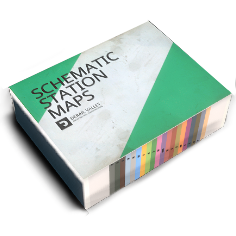Headlights & Cab Lights: Difference between revisions
importing old manual |
m Tweaks |
||
| (6 intermediate revisions by 3 users not shown) | |||
| Line 1: | Line 1: | ||
<languages /> | <languages /> | ||
<translate> | <translate> | ||
<!--T:1--> | <!--T:1--> | ||
Most {{pll|Rail Vehicle Types|motorized rail vehicles}} come equipped with far-reaching headlights, helping see in the {{pll|Time of Day|dark}}. They also sometimes have taillights, glowing red, making the vehicle more visible from behind. | |||
<!--T:2--> | <!--T:2--> | ||
Typically, because rail vehicles can travel in two directions, they have both headlights and taillights on either end. | Typically, because rail vehicles can travel in {{pll|Reverser|two directions}}, they have both headlights and taillights on either end. Usually, you can configure the light type and intensity on both ends individually, using switches found in vehicle {{pll|Rail Vehicle Types|cabs}}. | ||
<!--T:3--> | <!--T:3--> | ||
In terms of lighting, a train is considered | In terms of lighting, a {{pll|Rail Vehicle Types|train}} is considered a single entity. As such it’s suggested to have headlights enabled at the very front, and taillights at the very end, with no lighting in-between, where they may be obstructed. | ||
<!--T:4--> | <!--T:4--> | ||
For example, if a locomotive is hauling cars behind it, its rear taillights should be disabled. | For example, if a {{pll|Rail Vehicle Types|locomotive}} is hauling {{pll|Rail Vehicle Types|cars}} behind it, its rear taillights should be disabled. | ||
<!--T:5--> | <!--T:5--> | ||
For vehicles that don’t have integrated taillights, such as a car at the end of a train or a steam locomotive, | For vehicles that don’t have integrated taillights, such as a car at the end of a train, or a {{pll|Steam Overview|steam}} locomotive, an {{pll|EOT Lantern|end-of-train (EOT) lantern}} should be mounted on its {{pll|Coupling|coupler}}. | ||
<!--T:6--> | <!--T:6--> | ||
At {{pll|Time of Day|daytime}} the headlights are suggested to be set to the dim "running" position in the direction of movement, whereas at {{pll|Time of Day|nighttime}} and in tunnels they are supposed to be in the "low beam" or "high beam" positions, depending on the {{pll|Weather|visibility}} outside. Using high beams in populated areas is discouraged. | |||
<!--T:7--> | <!--T:7--> | ||
The taillights | The taillights intensity is suggested to be set to match the headlights intensity, or to the closest equivalent. | ||
<!--T:8--> | <!--T:8--> | ||
It is possible to enable headlights in both directions, which is practical when shunting. | It is possible to enable headlights in both directions of a vehicle, which is practical when {{pll|Shunting|shunting}}. | ||
<!--T:9--> | <!--T:9--> | ||
In case of necessity, for example if headlights are broken due to body damage, or | In case of necessity, for example if headlights are broken due to {{pll|Body Damage|body damage}}, or due to a leading vehicle not having integrated headlights, a {{pll|Flashlight|flashlight}} can be used to illuminate the way and make the vehicle visible. | ||
<!--T:11--> | |||
Custom headlights, taillights, and other types of lights, can also be bought in {{pll|Shops|shops}}, and {{pll|Gadget Installation|installed as gadgets}}. | |||
<!--T:10--> | <!--T:10--> | ||
Vehicles typically also feature settings to illuminate the gauges or cabs. On others, a lantern | Vehicles typically also feature settings to illuminate the gauges or cabs. On others, there's an option of manually placing a {{pll|Lantern|lantern}}, possibly {{pll|Mounts|hung from the ceiling}}. | ||
<!--T:12--> | |||
As lights run on {{pll|Electricity|electricity}}, they require respective {{pll|Breakers|breakers}} to be enabled. | |||
</translate> | </translate> | ||
[[Category:Accessories|4]] | |||
[[Category:Accessories]] | |||
Latest revision as of 23:03, 3 April 2025
Most motorized rail vehicles come equipped with far-reaching headlights, helping see in the dark. They also sometimes have taillights, glowing red, making the vehicle more visible from behind.
Typically, because rail vehicles can travel in two directions, they have both headlights and taillights on either end. Usually, you can configure the light type and intensity on both ends individually, using switches found in vehicle cabs.
In terms of lighting, a train is considered a single entity. As such it’s suggested to have headlights enabled at the very front, and taillights at the very end, with no lighting in-between, where they may be obstructed.
For example, if a locomotive is hauling cars behind it, its rear taillights should be disabled.
For vehicles that don’t have integrated taillights, such as a car at the end of a train, or a steam locomotive, an end-of-train (EOT) lantern should be mounted on its coupler.
At daytime the headlights are suggested to be set to the dim "running" position in the direction of movement, whereas at nighttime and in tunnels they are supposed to be in the "low beam" or "high beam" positions, depending on the visibility outside. Using high beams in populated areas is discouraged.
The taillights intensity is suggested to be set to match the headlights intensity, or to the closest equivalent.
It is possible to enable headlights in both directions of a vehicle, which is practical when shunting.
In case of necessity, for example if headlights are broken due to body damage, or due to a leading vehicle not having integrated headlights, a flashlight can be used to illuminate the way and make the vehicle visible.
Custom headlights, taillights, and other types of lights, can also be bought in shops, and installed as gadgets.
Vehicles typically also feature settings to illuminate the gauges or cabs. On others, there's an option of manually placing a lantern, possibly hung from the ceiling.
As lights run on electricity, they require respective breakers to be enabled.
